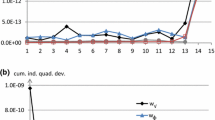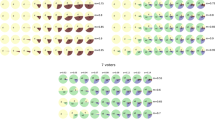Abstract
The paper investigates how voting weights should be assigned to differently sized constituencies of an assembly. The one-person, one-vote principle is interpreted as calling for a priori equal indirect influence on decisions. The latter are elements of a one-dimensional convex policy space and may result from strategic behavior consistent with the median voter theorem. Numerous artificial constituency configurations, the EU and the US are investigated by Monte–Carlo simulations. Penrose’s square root rule, which originally applies to preference-free dichotomous decision environments and holds only under very specific conditions, comes close to ensuring equal representation. It is thus more robust than previously suggested.
Similar content being viewed by others
References
Algaba E, Bilbao JM, Fernández García JR, López JJ (2003) Computing power indices in weighted multiple majority games. Math Soc Sci 46:63–80
Ansolabehere S, Gerber A, Snyder J (2002) Equal votes, equal money: court-ordered redistricting and the distribution of public expenditures in the American States. Am Polit Sci Rev 96(4):767–777
Arnold BC, Balakrishnan N, Nagaraja HN (1992) A first course in order statistics. Wiley, New York
Baldwin R, Widgrén M (2004) Council voting in the constitutional treaty: devil in the details. Policy Brief 53, Centre for European Policy Studies
Baldwin RE, Berglöf E, Giavazzi F, Widgrén M (2001) Nice try: should the Treaty of Nice be ratified? Monitoring European Integration 11. Center for Economic Policy Research, London
Balinski ML, Young HP (2001) Fair representation – meeting the ideal of one man, one vote, 2nd edn. Brookings Institution Press, Washington
Banks JS, Duggan J (2000) A bargaining model of social choice. Am Polit Sci Rev 94(1):73–88
Banzhaf JF (1965) Weighted voting doesn’t work: a mathematical analysis. Rutgers Law Rev 19(2):317–343
Banzhaf JF (1968) One man, 3.312 votes: a mathematical analysis of the Electoral College. Villanova Law Rev 13:304–332
Barberà S, Jackson MO (2006) On the weight of nations: Assigning voting power to heterogeneous voters. J Polit Economy 114(2):317–339
Beisbart C, Bovens L (2005) Why degressive proportionality? An argument from cartel formation. Mimeo, University of Dortmund and London School of Economics
Beisbart C, Bovens L, Hartmann S (2005) A utilitarian assessment of alternative decision rules in the Council of Ministers. Eur Union Polit 6(4):395–419
Bilbao JM, Bobay F, Kirsch W, Machover M, McLean I, Plechanovová B, Pukelsheim F, Slomczynski W, Zyczkowski K et al. (2004) Letter to the governments of the EU member states. URL (consulted last in April 2006): http://www.esi2.us.es/~mbilbao/pdffiles/letter.pdf
Brams SJ (1978) The presidential election game. Yale University Press, New Haven
Buchanan JM, Tullock G (1962) The calculus of consent. University of Michigan Press, Ann Arbor
Chamberlain G, Rothschild M (1981) A note on the probability of casting a decisive vote. J Econ Theory 25:152–162
Chang P-L, Chua VC, Machover M (2006) L S Penrose’s limit theorem: Tests by simulation. Math Soc Sci 51(1):90–106
Epstein D, O’Halloran S (1999) Measuring the electoral and policy impact of majority-minority voting districts. Am J Polit Sci 43(2):367–395
Feix MR, Lepelley D, Merlin V, Rouet J-L, Vidu L (2005) Majority efficient representation of the citizens in a federal union. Mimeo, Université de la Réunion, Université de Caen, and Université d’Orleans
Felsenthal D, Machover M (1998) The measurement of voting power—theory and practice, problems and paradoxes. Edward Elgar, Cheltenham
Felsenthal D, Machover M (2001) The Treaty of Nice and qualified majority voting. Soc Choice Welfare 18(3):431–464
Felsenthal D, Machover M (2004) Analysis of QM rules in the draft Constitution for Europe proposed by the European Convention, 2003. Soc Choice Welfare 23(1):1–20
Gabaix X (1999) Zipf’s law for cities: an explanation. Q J Econ 114:739–767
Gelman A, Katz JN, Tuerlinckx F (2002) The mathematics and statistics of voting power. Stat Sci 17:420–435
Gelman A, Katz JN, Bafumi J (2004) Standard voting power indexes don’t work: an empirical analysis. Br J Polit Sci 34(1133):657–674
Good I, Mayer L.S. (1975) Estimating the efficacy of a vote. Behav Sci 20:25–33
Horiuchi Y, Saito J (2003) Reapportionmente and redistribution: consequences of electoral reform in Japan. Am J Polit Sci 47(4):669–682
Laruelle A, Martínez R, Valenciano F (2006) Success versus decisiveness: conceptual discussion and case study. J Theor Polit 18(2):185–205
Leech D (2002) Designing the voting system for the EU Council of Ministers. Public Choice 113(3–4):437–464
Leech D (2003) Power indices as an aid to institutional design: the generalised apportionment problem. In: Holler MJ, Kliemt H, Schmidtchen D, Streit M (eds) Jahrbuch für Neue Politische Ökonomie, vol 22, pp. 107–121. Mohr Siebeck, Tübingen
Leech D, Machover M (2003) Qualified majority voting: the effect of the quota. In: Holler MJ, Kliemt H, Schmidtchen D, Streit ME (eds) Jahrbuch für Neue Politische Ökonomie, vol 22, pp. 127–143. Mohr Siebeck, Tübingen
Lindner I, Machover M (2004) L. S. Penrose’s limit theorem: proof of some special cases. Math Soc Sci 47:37–49
Mann I, Shapley LS (1960) Values of large games, IV: evaluating the electoral college by Monte Carlo techniques. Memorandum RM-2651, The Rand Corporation
Mann I, Shapley LS (1962) Values of large games, VI: evaluating the electoral college exactly. Memorandum RM-3158-PR, The Rand Corporation
Metropolis N, Ulam S (1949) The Monte Carlo method. J Am Stat Assoc 44:335–341
Napel S, Widgrén M (2006) The inter-institutional distribution of power in EU codecision. Soc Choice Welfare 27(1):129–154
Newman N (2000) The power of design. Nature 405:412–413
Penrose LS (1946) The elementary statistics of majority voting. J R Stat Soc 109:53–57
Reed WJ (2004) On the rank-size distribution for human settlements. J Reg Sci 42:1–17
Shapley LS, Shubik M (1954) A method for evaluating the distribution of power in a committee system. Am Polit Sci Rev 48(3):787–792
Stratmann T, Baur M (2002) Plurality rule, proportional representation, and the German Bundestag: how incentives to pork-barrel differ across electoral systems. Am J Polit Sci 46(3):506–514
Taylor AD, Zwicker WS (1999) Simple games. Princeton University Press, Princeton
Author information
Authors and Affiliations
Corresponding author
Rights and permissions
About this article
Cite this article
Maaser, N., Napel, S. Equal representation in two-tier voting systems. Soc Choice Welfare 28, 401–420 (2007). https://doi.org/10.1007/s00355-006-0186-z
Received:
Accepted:
Published:
Issue Date:
DOI: https://doi.org/10.1007/s00355-006-0186-z




